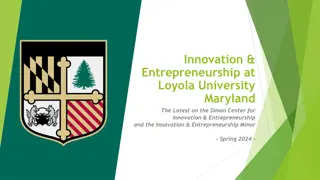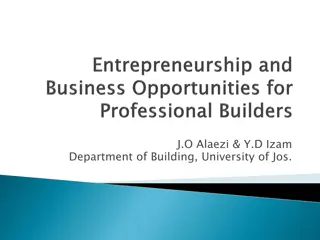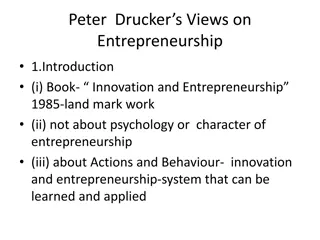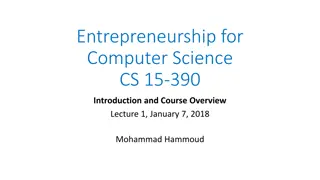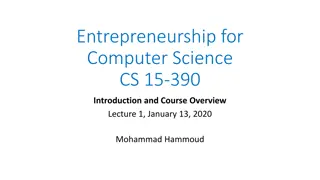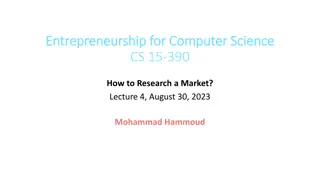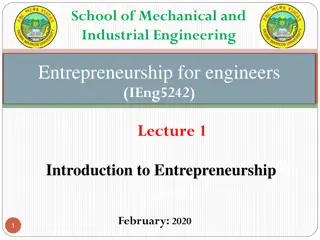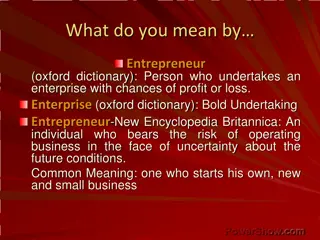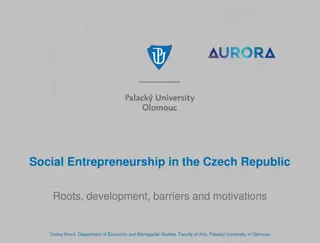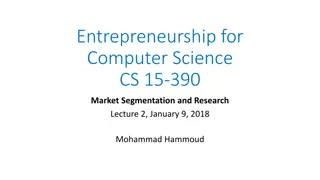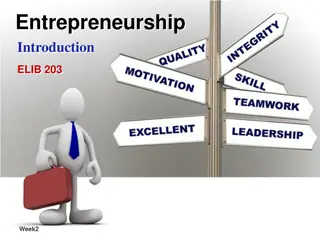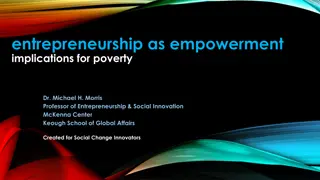Deciding Between Solo or Co-Founding in Entrepreneurship for Computer Science
Today's lecture in the Entrepreneurship for Computer Science course explores the decision of starting a company solo or co-founding. It emphasizes the importance of finding a co-founder who shares your values and vision while managing partnership tensions effectively. The lecture also covers roles and rewards in founding a company, guiding students through the entrepreneurship paradigm and key questions to consider before embarking on the entrepreneurial journey.
Download Presentation

Please find below an Image/Link to download the presentation.
The content on the website is provided AS IS for your information and personal use only. It may not be sold, licensed, or shared on other websites without obtaining consent from the author. Download presentation by click this link. If you encounter any issues during the download, it is possible that the publisher has removed the file from their server.
E N D
Presentation Transcript
Entrepreneurship for Computer Science Entrepreneurship for Computer Science CS 15-390 Should I Found or Co-Found? Part III Lecture 7, September 25, 2023 Mohammad Hammoud
Today Last Lecture: Shall I start a company, and if so, should I go solo or co-found? Part II Principle 6: Find a Co-founder Who Shares Your Values and Vision, and Complements You Principle 7: Manage Partnership Tensions Quickly and Properly Today s Lecture: Shall I start a company, and if so, should I go solo or co-found? Part III Roles and Rewards Announcements: Student presentations are on September 27 Report 2 is due on September 27 by midnight (rubric has been shared on Piazza) Midterm exam will be on Oct 16 (all materials are included)
Entrepreneurship Paradigm A System of Functions Paradigm: Functions Identify & Research a Market Found or Co-found a Company Build a Business Model Identify a Problem Build a Prototype Bootstrap and/or Raise Angle Fund Raise Market & Operate Build a Culture Build an MVP Professional Money Scale Exit
Entrepreneurship Paradigm A System of Functions Paradigm: Functions Identify & Research a Market Found or Co-found a Company Build a Business Model Identify a Problem Build a Prototype Bootstrap and/or Raise Angle Fund Raise Market & Operate Build a Culture Build an MVP Professional Money Scale Exit
Founding Questions? Deal with the 3Rs Dilemmas: Relationships? Roles? Rewards? YES NO Should I be a Solo Founder? Should I Found Now? YES NO Continue the journey Remain Non-founder Continue the journey
Founding Questions? Deal with the 3Rs Dilemmas: Relationships? Roles? Rewards? YES NO Should I be a Solo Founder? Should I Found Now? YES NO Continue the journey Remain Non-founder Continue the journey
Roles: Overlapping vs. Division of Labor Roles Strengths Weaknesses Provides better accountability In heterogeneous teams, enables the team to fit role assignments to founders strengths May be hard to get founders to collaborate on cross-cutting tasks (!) In homogenous teams, may cause early suboptimal role assignments Division of Labor Offers flexibility and redundancy appropriate to early-stage startups Taps into collective knowledge of all team members May increase tension as founders may step on each other s toes As the startup evolves, founders may resist having to focus on specific functions or areas (also may increase tensions) Overlapping Roles
Roles: Overlapping vs. Division of Labor Roles Strengths Weaknesses Provides better accountability In heterogeneous teams, enables the team to fit role assignments to founders strengths May be hard to get founders to collaborate on cross-cutting tasks (!) In homogenous teams, may cause early suboptimal role assignments Division of Labor Offers flexibility and redundancy appropriate to early-stage startups Taps into collective knowledge of all team members May increase tension as founders may step on each other s toes As the startup evolves, founders may resist having to focus on specific functions or areas (also may increase tensions) Overlapping Roles
Roles: Overlapping vs. Division of Labor Roles Strengths Weaknesses Provides better accountability In heterogeneous teams, enables the team to fit role assignments to founders strengths May be hard to get founders to collaborate on cross-cutting tasks (!) In homogenous teams, may cause early suboptimal role assignments Division of Labor Offers flexibility and redundancy appropriate to early-stage startups Taps into collective knowledge of all team members May increase tension as founders may step on each other s toes As the startup evolves, founders may resist having to focus on specific functions or areas (also may increase tensions) Overlapping Roles
Roles: Overlapping vs. Division of Labor Roles Strengths Weaknesses Provides better accountability In heterogeneous teams, enables the team to fit role assignments to founders strengths May be hard to get founders to collaborate on cross-cutting tasks (!) In homogenous teams, may cause early suboptimal role assignments Division of Labor Offers flexibility and redundancy appropriate to early-stage startups Taps into collective knowledge of all team members May increase tension as founders may step on each other s toes As the startup evolves, founders may resist having to focus on specific functions or areas (also may increase tensions) Overlapping Roles
Roles: Overlapping vs. Division of Labor Roles Strengths Weaknesses Provides better accountability In heterogeneous teams, enables the team to fit role assignments to founders strengths May be hard to get founders to collaborate on cross-cutting tasks (!) In homogenous teams, may cause early suboptimal role assignments Division of Labor Offers flexibility and redundancy appropriate to early-stage startups Taps into collective knowledge of all team members May increase tension as founders may step on each other s toes As the startup evolves, founders may resist having to focus on specific functions or areas (also may increase tensions) Overlapping Roles
Roles: Overlapping vs. Division of Labor Roles Strengths Weaknesses Provides better accountability In heterogeneous teams, enables the team to fit role assignments to founders strengths May be hard to get founders to collaborate on cross-cutting tasks (!) In homogenous teams, may cause early suboptimal role assignments Division of Labor Offers flexibility and redundancy appropriate to early-stage startups Taps into collective knowledge of all team members May increase tension as founders may step on each other s toes As the startup evolves, founders may resist having to focus on specific functions or areas (also may increase tensions) Overlapping Roles
Roles: Overlapping vs. Division of Labor Roles Strengths Weaknesses Provides better accountability In heterogeneous teams, enables the team to fit role assignments to founders strengths May be hard to get founders to collaborate on cross-cutting tasks (!) In homogenous teams, may cause early suboptimal role assignments Division of Labor Offers flexibility and redundancy appropriate to early-stage startups Taps into collective knowledge of all team members May increase tension as founders may step on each other s toes As the startup evolves, founders may resist having to focus on specific functions or areas (also may increase tensions) Overlapping Roles
Roles: Overlapping vs. Division of Labor Roles Strengths Weaknesses Provides better accountability In heterogeneous teams, enables the team to fit role assignments to founders strengths May be hard to get founders to collaborate on cross-cutting tasks (!) In homogenous teams, may cause early suboptimal role assignments Division of Labor Offers flexibility and redundancy appropriate to early-stage startups Taps into collective knowledge of all team members May increase tension as founders may step on each other s toes As the startup evolves, founders may resist having to focus on specific functions or areas (also may increase tensions) Overlapping Roles
Roles: Overlapping vs. Division of Labor Roles Strengths Weaknesses Provides better accountability In heterogeneous teams, enables the team to fit role assignments to founders strengths May be hard to get founders to collaborate on cross-cutting tasks (!) In homogenous teams, may cause early suboptimal role assignments Division of Labor Offers flexibility and redundancy appropriate to early-stage startups Taps into collective knowledge of all team members May increase tension as founders may step on each other s toes As the startup evolves, founders may resist having to focus on specific functions or areas (also may increase tensions) Overlapping Roles
Founding Questions? Deal with the 3Rs Dilemmas: Relationships? Roles? Rewards? YES NO Should I be a Solo Founder? Should I Found Now? YES NO Continue the journey Remain Non-founder Continue the journey
Founding Questions? Deal with the 3Rs Dilemmas: Relationships? Roles? Rewards? YES NO Should I be a Solo Founder? Should I Found Now? YES NO Continue the journey Remain Non-founder Continue the journey
Rewards: When to Split? Split Earlier Split Later Attract key players who need equity incentives Negotiate calmly before you are under pressure to split Learn about co-founders contributions Learn about co-founders commitments
Criteria For Equity Splits There are no right answers or objective criteria that can be used to split equity The outcome is fully subject to negotiation between the founders But research shows that there are at least 4 criteria that can be considered for crafting a sustainable equity agreement 1. Past and Present Contributions 2. Future Contributions 3. Opportunity Cost 4. Motivations and Preferences
Past and Present Contributions How much have you contributed so far to building the value of the startup? Idea Contribution: Founders who contributed the original idea on which the startup is based have made a unique contribution to the venture Research suggests that they get an idea premium of 10-15% in extra equity Capital Contribution: Founders who have made larger contributions to the startup s seed capital should see a proportionate increase in their equity ownership
Future Contributions Most of the work required for the startup will come in the future, but these are hard to anticipate How much can you be expected to contribute to the value of the startup down the road? Are You a Successful Serial Founder? -- Research shows that serial founders are usually given a premium of 7% to 9% of extra equity What Will Be Your Title? -- Official positions influence equity splits, with CEOs receiving a substantial equity premium (i.e., 14% to 20% of extra equity) What is Your Level of Commitment? Being full-time or part-time in the startup may serve in changing your equity split
Opportunity Cost What are you sacrificing to build the startup? Are you employed or not employed? If not employed, the opportunity cost will be lower If employed, do you hold a low- or a high-level position which you re enjoying and having a financial security from? High-level positions entail higher opportunity cost and accordingly higher equity stake The calculus changes if you contribute part or all of your salary towards building the startup (this goes back to Past and Present Contributions )
Motivations and Preferences Motivation affects how much priority you place on gaining equity (benefit is long-term) versus cash compensation (benefit is short-term) In addition, personality (e.g., having tolerance for conflicts) affects a founder s willingness to engage in negotiations The higher the tolerance for conflicts, the higher the likelihood to pursue late equity split (quick equal splits are typically made to avoid difficult negotiations) Prior relationships affect expectations about equity splits This brings about an important theory in entrepreneurship called equity theory
Equity Theory Equity theory highlights the tight linkage between social factors (relationships) and economic factors (rewards) Founding teams usually operate under social logic or business logic For teams operating under social logic, preserving personal relationships takes precedence over maximizing business success These teams typically follow the rule of equal distribution (i.e., they split equity equally, even if individuals have very different levels of contribution) For teams operating under business logic, maximizing business success takes precedence over preserving personal relationships These teams typically follow the rule of equitable distribution (i.e., they split equity in proportion to the value of each individual s contribution)
Equity Theory Equity theory ultimately suggests that the best split for one type of team could be the worst equity split for another type of team, depending on the dominant logic operating in the specific circumstance
Linkage Between Prior Relationships, Equity Splits, and Team Stability Prior Relationship Social Relationship (Family, Friends) Prior Coworkers Stable Team Unstable Team (inconsistent with business logic) Rule of Equal Distribution Basis For Equity Split Unstable Team (inconsistent with social logic) Most Stable Team Rule of Equitable Distribution
Linkage Between Prior Relationships, Equity Splits, and Team Stability Prior Relationship Social Relationship (Family, Friends) Prior Coworkers Stable Team Unstable Team (inconsistent with business logic) Rule of Equal Distribution Basis For Equity Split Unstable Team (inconsistent with social logic) Most Stable Team Rule of Equitable Distribution
Linkage Between Prior Relationships, Equity Splits, and Team Stability Prior Relationship Social Relationship (Family, Friends) Prior Coworkers Stable Team Unstable Team (Inconsistent with Business Logic) Rule of Equal Distribution Basis For Equity Split Unstable Team (inconsistent with social logic) Most Stable Team Rule of Equitable Distribution
Linkage Between Prior Relationships, Equity Splits, and Team Stability Prior Relationship Social Relationship (Family, Friends) Prior Coworkers Stable Team Unstable Team (Inconsistent with Business Logic) Rule of Equal Distribution Basis For Equity Split Unstable Team (Inconsistent with Social Logic) Most Stable Team Rule of Equitable Distribution
Linkage Between Prior Relationships, Equity Splits, and Team Stability Prior Relationship Social Relationship (Family, Friends) Prior Coworkers Stable Team Unstable Team (Inconsistent with Business Logic) Rule of Equal Distribution Basis For Equity Split Unstable Team (Inconsistent with Social Logic) Most Stable Team Rule of Equitable Distribution
Next Lecture Building a prototype Business Models -- Part I


